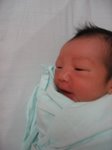

There is no standard for when our little ones teething will be begin, how long it will take or how painful it will be. A baby's first tooth usually comes in around the seventh month, although it can arrive as early as three months or late as a year. Heard from my sister in law that her son and daughter start teething in the ninth month and my colleague's son already teething at around sixth month.
Here are some common signs and symptoms of teething to share:
Swelling - Swelling of the gum tissue is usually the first sign of impending tooth eruption.
Flushing or rash - Your child's cheek may appear flushed or develop a slight rash near where the tooth is erupting.
Drooling - Teething babies usually produce more saliva and will drool excessively.
Crankiness - Teething babies are often unusually cranky and irritable, and may not sleep well.
Try the following tips to help soothe teething pain:Biting hard objects - Give your child hard objects such as teething rings, as these can ease some of the pain.
Cold - Frozen food such as a popsicle or frozen banana may also soothe your baby's gums during teething.
Numbing - There are several baby-safe teething gels available, such as Baby Orajel or Baby Ambesol, that you can apply directly to your baby's sore gums. However, some of these gels contain sugar so use them sparingly.
Baby ibuprofen - If your baby is going through a particularly painful phase, baby ibuprofen may help. As always, check with your pediatrician before giving any medication to your baby.























